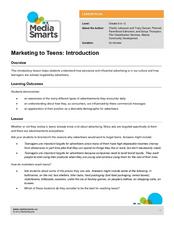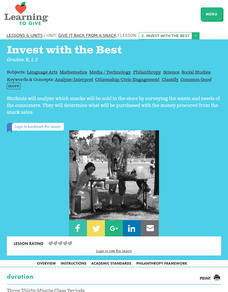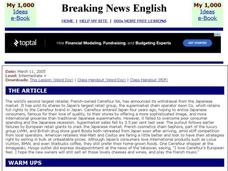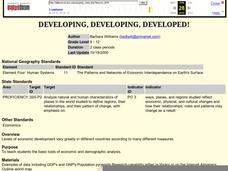Curated OER
Consumerism Scavenger Hunt
In this social studies activity, students discover how to be an informed consumer by first reading 10 questions pertaining to marketing, advertising and purchasing choices. Students use Internet searches to find the answers. There are...
Curated OER
Meet Molly An American Girl
Students examine concepts of personal finance. In this personal finance lesson, students use Valerie Tripp's, Meet Molly, An American Girl, to learn about saving and spending after World War II. They compare financial decisions after...
Curated OER
Smart Consumers, Smart Choices
Students see what it means to be a smart consumer by engaging in a level-headed analysis of budget, opportunity costs and self-regulation. They compare prices within a service field, and weigh the choices of spending money on that item.
Curated OER
Marketing to Teens: Introduction
An introductory lesson shows learners how pervasive and influential advertising is in our culture; particularly, how teenagers are actively targeted by advertisers. As teenagers, your learners already have all the information they need...
Curated OER
Consumerism Scavenger Hunt
Students explore consumerism. In this economics lesson, students work with a partner to complete an Internet Research consumer scavenger hunt. Students discuss information collected and conflicting answers to various questions.
ProCon
Obamacare
Former President Barack Obama reformed the United States' health care system with Obamacare, but is the new legislation good for America? Scholars read a historical timeline about the passage of health care reform laws and compare United...
Curated OER
Give It Back From a Snack Lesson 2: Invest With the Best
Students survey schoolmate as to what type of snacks they would prefer to purchase. They graph the results and apply them to planning a classroom snack sale while examining what wants, needs, and consumers are.
Curated OER
Financial Contracts
Prepare your class for the real world and learn the basics about credit and the principles behind using it wisely. The activity includes handouts that explain the necessary vocabulary and concepts to understanding credit. After reviewing...
Curated OER
Over-the-Counter Culture
Students explore the changing consumer habits of Americans of various socioeconomic classes. They examine the exact costs of products, services and interest rates mentioned in the article and reflect on their own spending habits and...
Curated OER
Using Credit: Not for a Billion Gazillion Dollars
Fifth graders explore the concept of credit. In this consumer education lesson, the teacher uses the book Not for a Billion Gazillion Dollars to lead the class in a discussion about credit, debit, and income. Students then analyze their...
Curated OER
Made You Look
High schoolers spend some time in the world of marketing and advertising by analyzing and creating slogans and campaigns geared toward adolescents. Students work with a partner to create their design and share with the class
Curated OER
Meet Molly, An American Girl
Students examine saving and spending decisions in 1944 through the eyes of Molly, a nine-year-old growing up during World War II. The lesson plan uses Meet Molly, An American Girl, by Valerie Tripp.
Curated OER
Are You Plugged In?
Students develop an awareness of one's own media habits. Make connections between ads and one's own consumer behavior. They track their current TV and/or Internet viewing habits and video game time by keeping a TV Diary for one week.
Curated OER
Photo Reports Make it Happen
Pupils use detailed instructions to organize, research, write and present an impressive report or slide show to an audience.
Curated OER
Breaking News English: Supermarkets
In this supermarkets worksheet, learners read the article, answer true and false questions, complete synonym matching, complete phrase matching, complete a gap fill, answer short answer questions, answer discussion questions, write, and...
Curated OER
Journalism: Underage Drinking
Students research underage drinking and read a report in the Journal of the American Medical Association about the issue. They interview experts on substance abuse and liquor store owners about their policies. Students publish their...
Curated OER
Making Grading Manageable, Efficient, and Purposeful
Maintain your workload through focused assignments, expressed objectives, and clear rubrics
Curated OER
Big Branding on Campus: Reading Informational Text
This New York Times "Learning Network" activity poses 11 questions on an article and video about commercial branding and marketing on college campuses. The related article, "On the Market: Thinking Critically About Advertising", is...
Curated OER
Locating Information Quickly in a Variety of Resources
Here is a lesson which may be best suited for a library science teacher, or one that can be done by a regular teacher when in the library. In it, learners explore the best ways to use print and electronic resources to find information...
Houghton Mifflin Harcourt
Finding Subjects and Predicates
Diagramming sentences has never been easier. Four worksheets feature exercises on simple subject and predicates, complete subjects and predicates, as well as compound verbs. Kids indicate the parts of the sentences with circles and...
Curated OER
Understanding the Influence of the Media
Critically analyze advertising techniques, such as circular reasoning, bandwagon, testimonial, and repetition, with worksheets that effectively discuss and illustrate how the media aims to influence.
Federal Reserve Bank
Financial Fables: Shopping Wisely with Olivia Owl
Cover two subjects with one instructional activity! First, dive into English language arts; read an eBook, answer comprehension questions, and complete a cause and effect chart about the financial fable, Shopping Wisely with Olivia...
K12 Reader
Plants Are Producers
Here's a handy two-part activity that uses an article about plants to assess reading comprehension. After reading the passage, kids answer questions based on the information in the text.
Curated OER
Developing, Developing, Developed!
Young scholars differentiate among and explain various levels of economic development around the world. They see that levels of economic development vary greatly in different countries according to many different measures.























